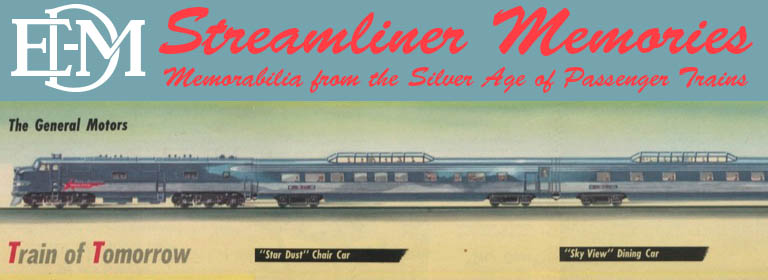The railroads hired many artists to make posters and other illustrations used in railroad brochures and advertising. Some of these artists were notable for their fine art as well and a few were primarily noted for their fine art.
After it opened hotels in Glacier National Park, Great Northern hired a number of artists to paint scenes in the park that it could use in the hotels. GN CEO Louis Hill eventually encountered a German artist named Winold Reiss who was painting Blackfoot Indians in and near the park. Hill bought scores of Reiss’ paintings, and Great Northern published many of them in a 1935 book as well as in portfolios in 1940 and 1958. Search for “Reiss” to see menus and other GN memorabilia that also featured Reiss’ work.
In the early 1920s, Great Northern also hired a Saskatchewan painter named Walter Loos to paint wildflowers in Glacier National Park. Loos’ wildflower painting later adorned the walls of the dining car on the streamlined Empire Builder and were also used to decorate Empire Builder and Western Star menus.
Northern Pacific also hired a German artist named Gustav Krollmann to paint passenger trains pulled by its 4-8-4 locomotives–known as “Northerns” because Northern Pacific was the first to use that wheel arrangement. Krollmann’s work borders on impressionism.
Santa Fe brought numerous artists to Taos, New Mexico, to portray desert scenery, Grand Canyon National Park, and the Indians who represented the railway’s trademark “Chief” trains. These included Sam Hyde Harris, Oscar Bryn, and Hernando Villa, among many others.
Southern Pacific also hired a number of interesting artists to make posters and other commercial advertising. These included Maurice Logan and Haines Hall.
On the East Coast, New Haven hired a number of artists both to portray its trains and to advertise the New England ski resorts that its trains accessed in winter. These included John Held, Jr. and Sascha Maurer.
Headquartered in Omaha, Union Pacific leaned toward an Omaha graphics firm headed by Kenneth and William Willmarth for most of its commercial art. When UP opened the Sun Valley ski resort in 1936, the Willmarths did a number of Sun Valley posters. Union Pacific also asked a number of other artists to make posters for its Sun Valley resort, but it must have liked the Willmarths, for its association with them lasted several more decades.
During World War II, the Willmarths did a series of war posters for UP. As the war was ending, UP asked them for a series of state-based “Your America” paintings. After the war, the Willmarths continued to contribute to Union Pacific advertising with a series of distinct pastel-colored images and scenic vacation ads. Willmarth illustrations were also found in numerous Union Pacific brochures, such as this map.
Streamliner Memories reader Robert Nisbet has written brief biographies of both William and Kenneth Willmarth which I am pleased to make available here.
During the Depression, some 30 western railroads pooled their artists and did a series of Travel by Train posters. These artists included Santa Fe’s, Union Pacific’s Willmarths, H.M. Veenstra, Frederic Mizen, and others who seem to be anonymous today.
During the streamlined era, Leslie Ragan became quite possibly the best-known commercial railroad artist. He did work for the Chicago, South Shore, and South Bend, New York Central, more NYC, as well as the Budd Company, including this Florida streamliner, RDCs, Great Northern Great Domes, and many others.
Less well-known than Leslie Ragan was an artist named Bern Hill, who made 65 paintings of Diesel-powered trains for General Motors in the early 1950s. These were all used as cover illustrations for Railway Age magazine (which sold its front cover to advertisers), and many were also printed as posters. Many of Hill’s paintings were striking because they didn’t attempt to accurately portray the train but instead showed the trains as a part of the gigantic landscape through which they travel. I’ve collected many of his passenger train paintings here and here, while some of his freight paintings are here.
A commercial artist named Bruce Bomberger did many ads for Chevrolet, Marlboro, and other companies. Some of his best work adorned California Zephyr ads. Other California Zephyr ad artwork was done by Gerhardt Hurt.
Canadian Pacific hired several artists to illustrate its streamlined Canadian. A painter named Hedley Rainnie did exterior and interior views of the train. (Rainnie also did some work for Santa Fe.) Other exterior views were done by an artist named Stan Galli, who worked for the same graphics company as Bruce Bomberger, and Chesley Bonestell. Canadian Pacific also published a series of posters by a variety of artists.
The Budd Company employed a number of artists to decorate its streamlined trains. A painter named Russell Patterson did double duty, both illustrating advertisements for the California Zephyr and painting murals in the train’s observation cars.
Pierre Bourdelle specialized in linoleum carvings, and his work appeared in dome cars on the California Zephyr observation car, the original California Zephyr dome-buffet car, North Coast Limited, Empire Builder, Denver Zephyr, Santa Fe, and Canadian. Other artists who contributed to some of these trains include Mary Lawser and David Harriton.
Another painter named Pearson Berlinghof provided the art in the glass panels in the lounges underneath GN‘s and Santa Fe‘s full-length domes. A painter named Edgar Miller illustrated the entire Lewis & Clark Expedition in Northern Pacific’s Traveller’s Rest cars. A painter named Katherine Fligg painted wildflowers that adorned the walls and menus of the Denver Zephyr.
I’ve tried to identify other artists as I find them. As I find significant ones, I’ll add them to this list.
